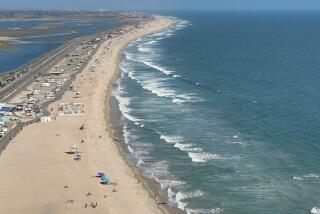He Dreams of a Beach--All Covered With Glass
- Share via
ENCINITAS — The synthetic-sand beaches that once gleamed in the dreams of a Leucadia lawn mower salesman are moving into the realm of the possible.
Preliminary studies by geologists working for Encinitas show that crushed glass recyclables seem to make a decent substitute for real sand, but the final results are not in yet. Finely crushed glass looks like sand and feels like sand, the geologists said, but environmental and financial questions still must be answered.
“Technically, yes, it has a reasonable chance of supplementing sand. It looks almost identical to beach sand, unless you look at it under a microscope,” said Dave Schug, a coastal geologist in San Diego. “But by no means are you going to see recycled glass all up and down the beach. At least not in the foreseeable future.”
Encinitas could one day become the first city in the nation, geologists say, to have a beach of glass to shore up its eroded coast.
“It looks like very colorful beach sand,” said Steve Sachs, a senior planner with the San Diego Assn. of Governments, whose shoreline erosion committee looks favorably on the new use for recycled glass. “It looked and felt pretty much like sand to me. . . . Everyone likes the idea.”
It was the vision of Dan Dalager of Leucadia, and his impressive bucket of home-made sand, that led the City Council to commission the $8,000 analysis of the sand.
“We’ll be able to redo the beaches here in Encinitas and make them totally bitchin’,” Dalager said. “My guess is there’s not going to be enough glass to do every beach in Southern California.
“The engineers told me: ‘At first we thought you were really stupid, but now we think it’s going to work,’ ” said Dalager, 42, who sits on the parks and recreation commission and co-owns a lawn mower store. “To me, it’s just so simple, so stupid, so easy.”
But geologists scrutinizing the fake sand are reluctant to promise that it will be the savior that beach lovers and imperiled bluff dwellers are praying for.
Because glass is less durable than natural sand, the grains are expected to wear down into extremely fine granules. But some fear that they could break down at angles and become sharp, exposing residents to sore feet and the city to huge liability.
Although the Dalager sand is a convincing imitation, many factors could foil the project, including the production cost and availability of recycled glass, Schug said.
But the biggest hurdle, Schug said, promises to be environmental. What if recycled glass contains contaminants that the study has yet to detect? Will the wildlife that thrives in true sand accept faux sand as a habitat?
Key questions about the Dalager sand will probably be answered over the next month of the study. But more questions are expected to emerge if the city seeks approval from the multitude of governmental agencies that would have to sign off on the venture.
If the study results are positive, an experimental beach of Dalager sand might be set up as early as next year. The tentative plan, said a city official, is to rope off a swath of Moonlight Beach and see how the sand behaves.
Although chemically glass is close to natural sand--both are primarily made of silica, a hard, glassy mineral--scientists wonder how the glass grains would withstand the pounding of the waves.
More to Read
Sign up for Essential California
The most important California stories and recommendations in your inbox every morning.
You may occasionally receive promotional content from the Los Angeles Times.













